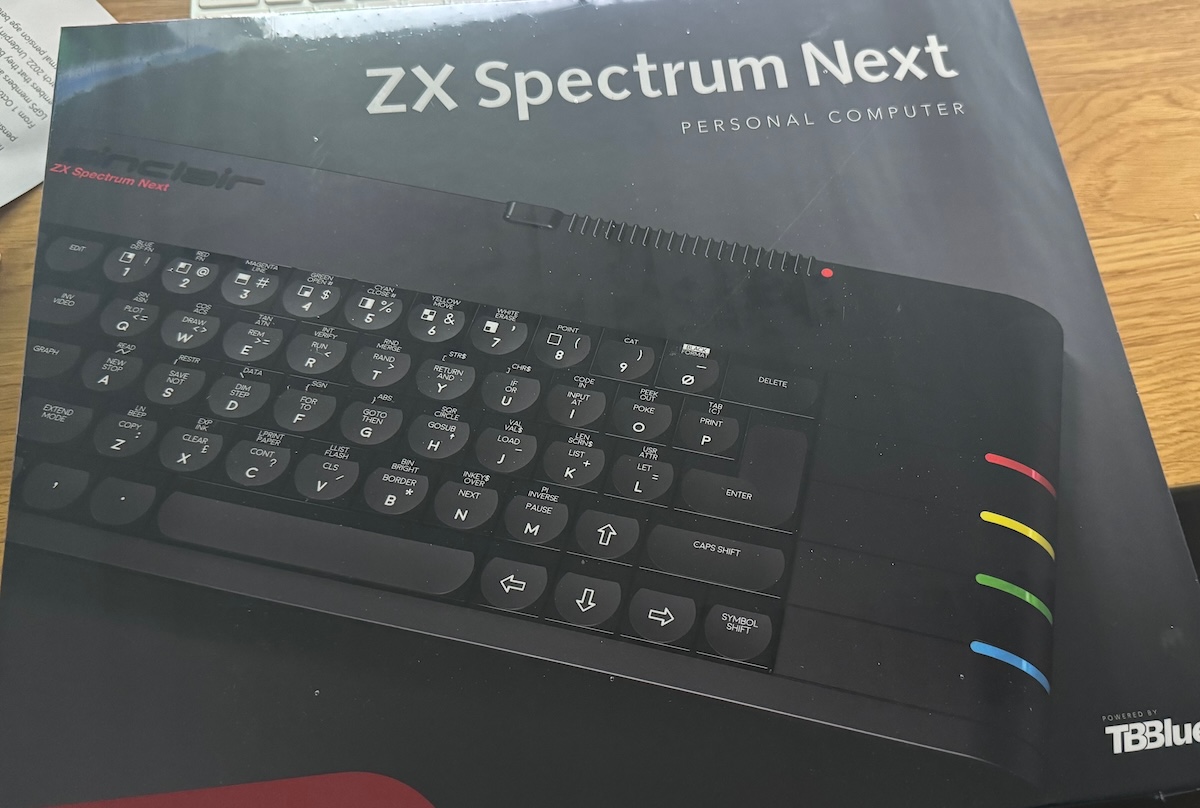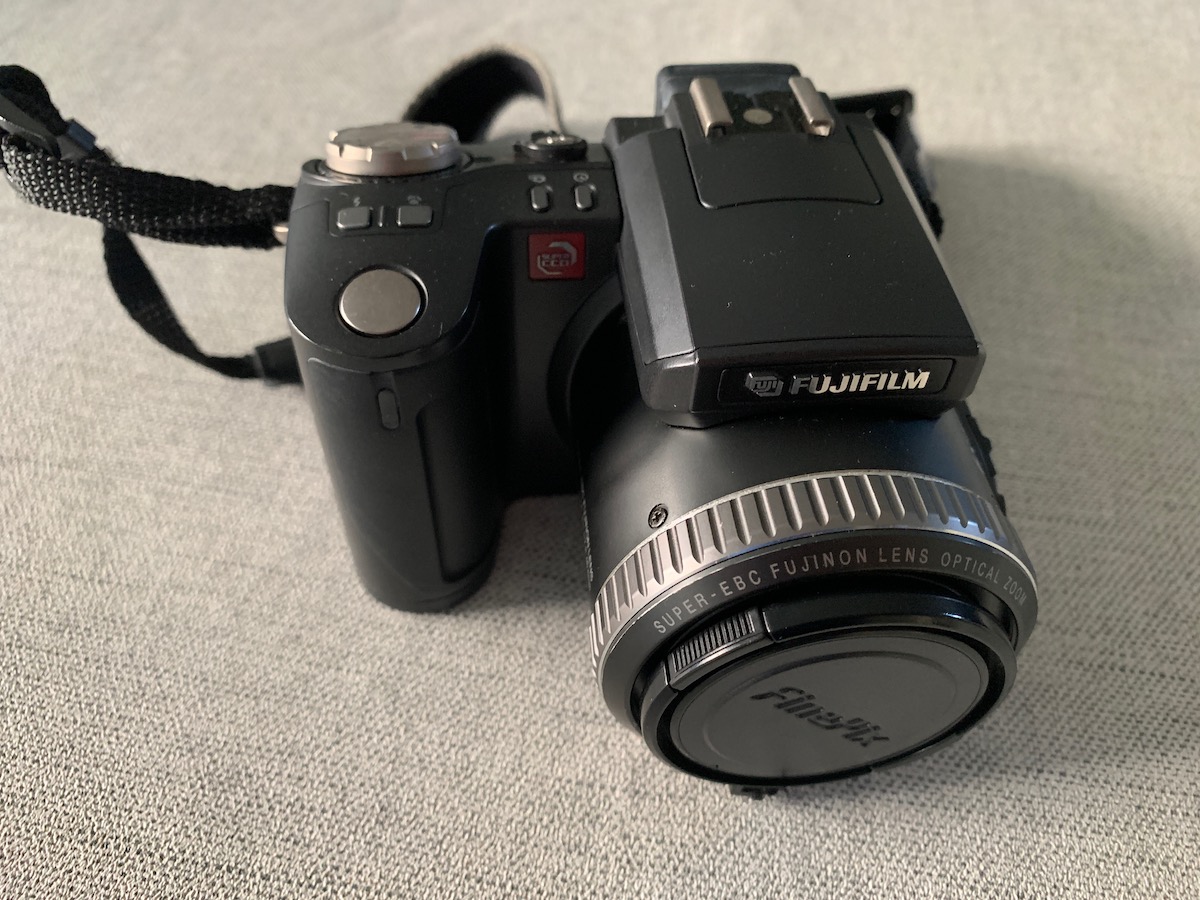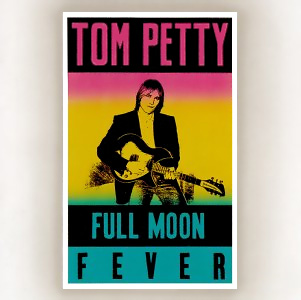Some 3.5 years ago, I signed up for a Kickstarter developing the Spectrum Next, a re-imagined version of the ZX Spectrum from 1982. This week the finished product finally arrived! So far, I have to say that I’m impressed by the build quality and operation. There’s a lot more to discover about this retro machine, which I’m hoping to post over the coming months.
Author: chris
Fujifilm FinePix 6900 Zoom
The last year has been one of decluttering and tidying. In that process, I found my first digital camera – the Fujifilm FinePix 6900 Zoom. I think I purchased this around 2002; the camera was released early 2001.

The specifications are interesting, compared with today’s cameras and smartphones. Maximum resolution was 2832 x 2128, producing a 3 megapixel image. ISO ranges were 100, 200 and 400, with aperture sizes from F2.8-3.1. At the time this seemed amazing, but we’ve had better phones than this for years.
Probably the most annoying attribute of the camera was shutter focus time. After clicking the shutter button, a picture could take maybe 1-2 seconds to complete, by which time a moving subject is already out of shot. This meant doing some creative pre-planning on the subjects movements to ensure an image was captured correctly. However, on the positive side, this camera had an eyepiece and rear display, making it great for holiday photos in bright sunlight.
I should mention storage, which was via SmartMedia cards or USB 1.0. The SmartMedia devices I had were a maximum of 128MB (yes megabytes, not gigabytes) and huge by comparison to today’s storage (see the image below). How technology has changed over time.

This camera was a great introduction to digital photography and it will be sad to see it go. However, it’s now 20 years old and way past what I can achieve with any other camera I own. Good times!
Performance Rights and Big Numbers
This week, the government is holding a hearing on the financials of the music industry, specifically around revenue from streaming compared to other forms of remuneration. This article from Sky News caught my eye, with Gary Numan unhappy that his streaming revenue for 1 million plays was only £37. I suspect that artists and others have a challenge understanding the mechanics of streaming versus radio and other revenue, so I thought it worth having a dig into the details.

Radio
Let’s start by comparing radio with streaming. The revenue generated from radio stations is naturally a closely guarded “secret” and available to only those who are members of PRS. However, this article references some numbers for the BBC. Cars and other Numan tracks are likely to be played on Radio 2, which in 2018 paid £22.77 per minute, or around £70 per track.
Radio 2 listeners are estimated at 14.44 millon over the course of a week. It’s difficult to translate that figure into a number that represents the average listener count, but taking this data into consideration, the average could be between one and two million.
Streams vs Plays
So, a single play on Radio 2 could reach between 1-2 million listeners, for which the royalty is £70 (approximately). This compares well with a return of £37 for 1 million plays. The content is reaching a similar audience size, with similar revenue returns, although we don’t know exactly how the BBC royalties are divided up. It could be that £37/million is a good figure for royalties received by streaming.
Big Numbers
Part of the challenge here is understanding the concept of big numbers. Receiving £70 for one play on Radio 2 seems great; receiving £37 for a million “plays” on a streaming service seems terrible. However, the two are not directly comparable, because reach is different.
If we look at the most popular streaming service, Spotify, the numbers are huge. The company boasts 320 million active users, with 144 million subscribers (the remainder receive adverts), with access to over 60 million songs.
Assuming every active user streams for one hour a day (or 20 songs), that represents 6.4 billion downloads, or every track played 100 times a day. if that were true, every track would only be downloaded less than 40,000 times a year.
Exponential
Now, we know that averages never work. In reality, the 80/20 rule generally applies and some songs will receive many more downloads, while others might never be accessed. The average user can stream perhaps 240 tracks a day (20 per hour) over a 12-hour period – from a collection of 60 million. Getting any plays at all is still a remarkable achievement, with so much competition for air time.
Commercial
The move to streaming represents a change in technology and commercials. As co-founder of a music company, I regularly produced PRS reports and paid royalties. The process was torturous, with so many companies and individuals claiming ownership of music rights. Much of this was based on geographies, specific albums and recordings and sub-licensing. Spotify must have a Herculean job in reconciling who is owed what money.
The entire music industry has changed since Gary Numan first released Cars in 1979. At the time, people purchased albums and played them forever. Fans invested time in their favourite bands. Today music has become almost throw-away and many artists treat their fans the same way. Music is a truly commercial enterprise.
Chris’ View
It’s testament to the quality of songs like Cars that they continue to get plays and downloads year on year. However, with every year that passes, the collective back catalogue of music grows and makes it ever difficult for any one track to stand out. Music artists, like everyone, need to be continually re-inventing and refreshing their music, rather than resting on the laurels of a track written 40 years ago. Streaming services are not unreasonably penalising artists. They offer access to hundreds of millions of listeners, in return for a cut of the profits. Try doing that yourself in this media noisy world and see how hard it can be.
The Problem with Test and Trace
This recent BBC article shines a rather sad light on the state of our community. There’s no excuse for rudeness, but I think we’ve reached this point due to a number of escalating issues that the government chooses never to address.
Scam Callers
There are real challenges in dealing with scam calls. I receive around 2-3 a day, some weeks (others not so much). Every call is using either a faked or a VoIP landline number for an obscure location, like the Outer Hebrides. No-one ever leaves a voicemail. The same challenge happens with withheld numbers. 99% of them are scam callers.
Fixing the problem of scam calls should be easy. However, the government chooses not to crack down and the old solutions such as Telephone Preference Service (TPS) don’t apply to overseas “boiler rooms”. Caller-ID should be easy to trace and align to certified numbers. After all, we do it today with website URLs and DNS names. The industry could solve this problem.
Transparency
Many people will be happy offering their data to the T&T service, knowing that it could help virus spread and reduce lives. Unfortunately, there’s little or no transparency from the government on how the data will be used.
This page provides some great detail on the way in which T&T should work. However the data protection statements are incredibly vague and don’t explain basics such as how long data is retained and who will have access to the data itself. The government needs to do more to build confidence in the system.
Competency
Then we get to the biggest challenge – competency. A few months ago we learned that the T&T system uses spreadsheets to share data, and even then is using them in the wrong way, probably due to old ODBC code that uses XLS rather than XLSX format.
When we’re promised a “world beating” system that’s eye watering in expense (£22 billion as quoted in November 2020), then we really deserve something better than the terrible app and the inefficient call handling system that we’ve received. While the £7000 a day figure might not be entirely accurate (more on that in a moment), the average person watching TV will wonder how on earth a government can justify such spending for so little in return.
Audit
A lot of revelations will likely appear in the months and years following the COVID-19 outbreak. I’m sure we’ll hear of collusion and favouritism in awarding contracts (and jobs), like we’ve seen already. By the time the investigations are complete, the MPs in question (and many companies) will be retired or dissolved. None of this builds trust with the general public.
The Final Reckoning
Governments don’t like to be called to account. This is especially true in the UK, but hasn’t been the case globally, where we’ve seen countries like New Zealand coming out of COVID-19 much earlier than the rest of the world. Geography helps there, but transparency, honesty and trust are the biggest winners. If there has to be a “lessons learned” exercise, it will be to understand that without trust and the respect that requires and earns, the UK and other similar countries will never be the leaders in resolving future pandemics.
Name and Shame
I’m not a great fan of the UK Honours system. Too often, honours are granted to those who have literally just done the job they have been paid for. Admittedly, some awards are for inspiring the nation rather than just being there, and Ben Stokes’ amazing finale in the cricket against New Zealand is a great example.
However, today we’ve seen a monumental mistake come to light, as we found out that the full contact details of all 1000+ New Year awards recipients 2020 had been published online.
It’s hard to imagine how this could have happened. The government has been publishing awards lists for years through their website. What went wrong this time?
It’s not a glitch
First of all, I hope that the government doesn’t claim a “computer glitch”. Computers do what we ask them to do. If a human presses the wrong button or uploads the wrong data, that’s not a glitch. If the software has been programmed incorrectly, that’s not a glitch. So let’s not use a glitch to swerve the real truth.
Human Error
Somewhere in the publication process, a human made a mistake. The wrong file was uploaded, either inadvertently or carelessly through bad process. Either way, a person is accountable. If the review we can expect into the failure finds a person is to blame, we need to see the person admonished in the correct way. If this was negligence, the individual should be sacked.
ICO
Where does this leave the 1000+ award holders and how can these failings be addressed? We theoretically have robust processes for managing data breaches in the UK, based off EU GDPR rules. The rules need to be strictly enforced in this situation. Fines should be imposed. Precedent should be set.
The more likely outcome is this issue will be pushed sideways, kicked into the long grass or whatever expression is your favourite. After a lengthy internal inquiry, we can expect that “human error” will be quoted as a factor and “lessons will be learned”. The most disappointing outcome is that no-one will take personal accountability. Perhaps this is reflective of the state of the world as we edge closer to 2020.
Should we be reducing our red meat intake?
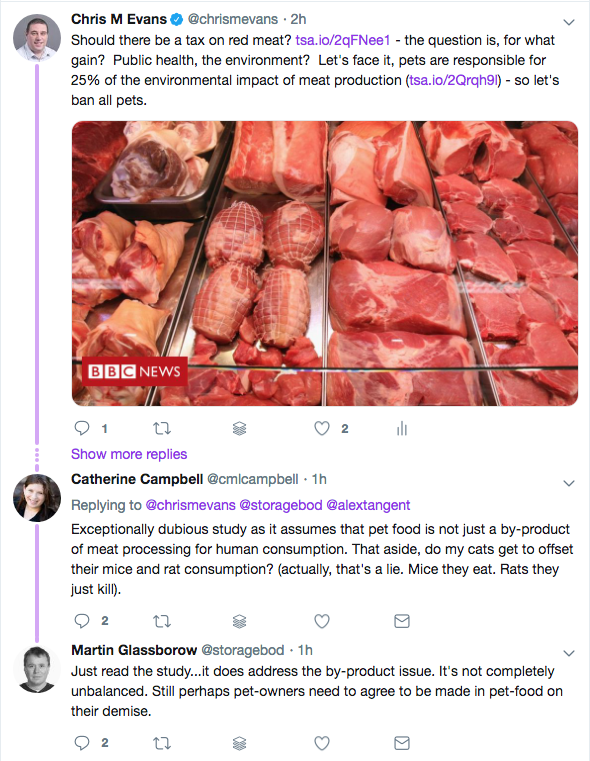 Although I posted this tweet somewhat tongue-in-cheek, the content of both the BBC News article and the research do raise some important issues. First is whether reduced red meat consumption would in fact save thousands of lives per year. I have no doubt that reduced red meat consumption would definitely benefit us all. The science behind processed meat consumption seems a little contradictory, although the general consensus is that sausages and bacon are “probably” bad for us.
Although I posted this tweet somewhat tongue-in-cheek, the content of both the BBC News article and the research do raise some important issues. First is whether reduced red meat consumption would in fact save thousands of lives per year. I have no doubt that reduced red meat consumption would definitely benefit us all. The science behind processed meat consumption seems a little contradictory, although the general consensus is that sausages and bacon are “probably” bad for us.
I use the term in quotes, because when you read analysis like this (link) from the NHS, the caveats and the assumptions are pretty wide. Ultimately, of course, reducing red meat consumption is one factor in improving heath. It would be useful if studies like this put the results in context. For example, compared to other “bad habits”, like smoking, drinking or doing no exercise, how significant is eating red meat?
We could use the “microlife” concept to establish a comparison. This shows we lose a microlife (or 30 minutes of our worldly existence) for each 85g portion of red meat we consume. Conversely, we gain 3-4 microlifes from eating our daily fruit and vegetables. Smoking a pack of cigarettes loses around 5 hours of life; 2-3 cups of coffee gains a microlife. Two hours of TV loses another microlife.
Can these be balanced up against each other? Does one cancel the other out? Probably not. But the measurements do give some order of magnitude understanding of the impacts of different types of risk factors.
Looking at my own diet, I would estimate that I have red meat perhaps 2-3 times a week. The remainder of the time it’s white meat (mainly chicken and pork), fish (white and oily) and seafood. Processed meat appears even less often with sausages and bacon being consumed maybe once every 2-3 weeks. Is this a conscious decision? Probably subtly unconscious, but based on reported news nonetheless. In general though, simply cutting out red meat isn’t going to save the planet or humanity, but instead a range of factors and behavioural improvements that we can all benefit from.
Dark Woods Coffee
I found Dark Woods Coffee through (of all places) Liberty of London. Liberty has a small groceries section in their store near Carnaby Street and Dark Woods is sold under the Liberty name. As a result I decided to buy directly, picking the Crow Tree I had before and a new choice – Under Milk Wood. As a blend this is a great coffee and does what it promises if you like milk in your drink.
It’s interesting that the UK-based coffee roasters aren’t that obvious to find, even though they invariably do have websites and online shops. The coffee I’ve purchased in the UK is easily as good as anywhere else, so there is plenty of skill around in achieving effective roasting.
I’m always on the lookout for new retailers, so if you know of any good ones, then share the love!
CD#472 – Speak & Spell – Depeche Mode
 Speak and Spell wasn’t an album I had when it first came out. In fact I only purchased a CD copy a few years ago. As with most of my music history, I listened to the radio and followed singles. As a result, tracks like New Life, Just Can’t Get Enough and Dreaming of Me are my bread and butter. Depeche Mode or “depeche-ay” as they seem to have been called in their early days (according to TOTP) has always been one of my favourite bands. I grew up with the synth sound in my early teens and the music still seems as fresh today as it did then.
Speak and Spell wasn’t an album I had when it first came out. In fact I only purchased a CD copy a few years ago. As with most of my music history, I listened to the radio and followed singles. As a result, tracks like New Life, Just Can’t Get Enough and Dreaming of Me are my bread and butter. Depeche Mode or “depeche-ay” as they seem to have been called in their early days (according to TOTP) has always been one of my favourite bands. I grew up with the synth sound in my early teens and the music still seems as fresh today as it did then.
The tracks on Speak & Spell are certainly an eclectic mix. The intro to New Life was a call to the dance floor (not that I did that much dancing). But that almost siren-sounding intro was an instant trigger to get up and move – and still is. New life has lots of intricate changes, but remains a consistent theme all the way through.
Contrast that to Just Can’t Get Enough, a classic Vince Clark riff, which has everyone tapping the tune out every time they hear it. The hook is enduring enough that 35+ years later, it still sounds great, despite the tinny and totally synthetic sound of the synthesiser on which is was written. Although the track sounds simple, the overlays of each melody are incredibly well interwoven that they sound effortless, but clearly aren’t.
So much of this album seems like an experiment. What can we try? What works, what doesn’t? What musical variations can we create? I Sometimes Wish I was Dead, with that very odd twinkling sound. This wouldn’t have been a successful single, but is a great album track (and only 2 minutes long). Puppets reminds me a little of Computer Love by Kraftwerk, pioneers of the synthesiser sound.
I like this album more and more as I play it. It shows that great tunes will last the test of time.
Favourite Track: Just Can’t Get Enough
- New Life – 3:47
- I Sometimes Wish I was Dead – 2:18
- Puppets – 3:57
- Boys Say Go! – 3:08
- Nodisco – 4:16
- What’s Your Name? – 2:46
- Photographic – 4;43
- Tora! Tora! Tora! – 4:39
- Big Muff – 4:25
- Any Second Now (Voices) – 2:35
- Just Can’t Get Enough – 3:45
- Dreaming of Me – 4:02
CD#370 – The Hurting – Tears for Fears
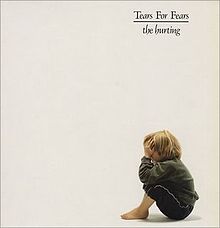 Which band can bring back memories of being a teenager better than Tears for Fears? Listening to songs for this album transports me instantly back to places and people. As a teenager I was definitely a singles fan, so put Mad World, Pale Shelter or Change on and I’m there – word perfect. However, I’m less familiar with the remainder of the album, most of which I consider to be typical album tracks, with the exception perhaps of The Way You Are (which is on my extended version).
Which band can bring back memories of being a teenager better than Tears for Fears? Listening to songs for this album transports me instantly back to places and people. As a teenager I was definitely a singles fan, so put Mad World, Pale Shelter or Change on and I’m there – word perfect. However, I’m less familiar with the remainder of the album, most of which I consider to be typical album tracks, with the exception perhaps of The Way You Are (which is on my extended version).
TFF are one of the bands that had a definite division to their early and late music. Comparing The Hurting to The Seeds of Love, released only six years later and there’s even more focus on production quality and detail, that is initially evident on the first album. Perhaps that’s why I liked them; I’m not a real fan of live music but prefer the consistency of hearing the tiny details in the master version of any music.
Change is definitely at the top for me as a favourite track, with what I guess is the glockenspiel chorus and the constant change of tempo and style throughout the song. As the Wikipedia entry for the album helps to clarify, there are additional tracks from the release/remaster in 1999 (the copy I have).
Favourite Track: Change
- The Hurting
- Mad World
- Pale Shelter
- Ideas as Opiates
- Memories Fade
- Suffer the Children
- Watch me Bleed
- Change
- The Prisoner
- Start of the Breakdown
- Pale Shelter (Long Version)
- The Way You Are (Extended)
- Mad World (World Remix)
- Change (Extended Version)
CD#066 – Full Moon Fever – Tom Petty
 It seems quite appropriate to start reviewing and listening to my CD collection in more detail with Tom Petty. Sadly Tom’s death was announced last week at the age of 66.
It seems quite appropriate to start reviewing and listening to my CD collection in more detail with Tom Petty. Sadly Tom’s death was announced last week at the age of 66.
Wikipedia tells me that the album went gold in the UK with over 100,000 sales. I’m not sure what directed me to Tom Petty (and the Heartbreakers) in the first place, but it may have been his involvement with the Travelling Wilburys. Whatever the reason, this is an album I’ve played so many times. I think of it as a classic style, mulitple songs that are singles in their own right, with hidden album gems like Zombie Zoo. The sound is so familiar, but of course that is bound to be due to the involvement of other Wilbury members like George Harrison and Jeff Lynne. Songs like “A Face in The Crowd” have a real Harrison feel. From memory this was a classic time for Harrison and Co (with Cloud Nine released two years earlier). Tom Petty offered a new angle to the Wilbury sound with more of a rock style.
There’s more than one influence here though. “I’ll Feel a Whole Lot Better” has a real resonance the 1960’s and “Needles and Pins” by The Searchers.
This album continues to be one of my favourites, with certain tracks hitting the top ten of the ones I play on iTunes.
Favourite Track: Zombie Zoo, a classic 3-minute pop song.
- Free Fallin’ – 4:17
- I Won’t Back Down – 2:58
- Love Is A Long Road – 4:08
- A Face In The Crowd – 3:59
- Runnin’ Down a Dream – 4:50
- I’ll Feel a Whole Lot Better – 2:50
- Yer So Bad – 3:05
- Depending On You – 2:49
- The Apartment Song – 2:33
- Alright For Now – 2:01
- A Mind with a Heart Of its Own – 3:31
- Zombie Zoo – 2:57
Wikipedia Page: Full Moon Fever
